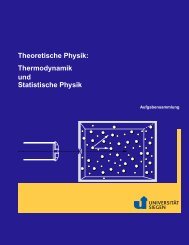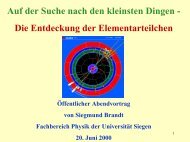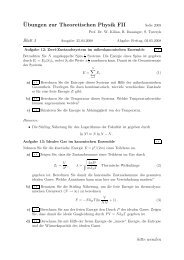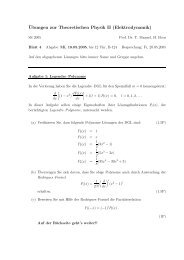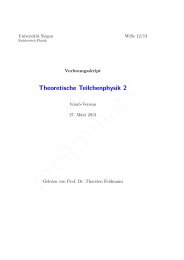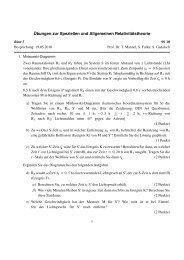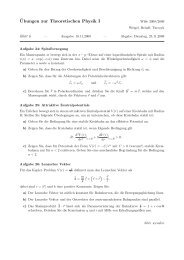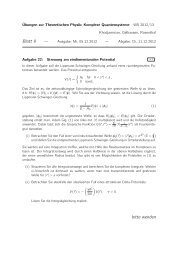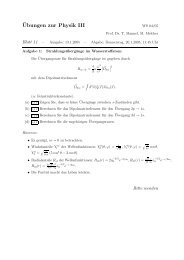Problems to Standard Model - Theoretische Physik 1 ...
Problems to Standard Model - Theoretische Physik 1 ...
Problems to Standard Model - Theoretische Physik 1 ...
You also want an ePaper? Increase the reach of your titles
YUMPU automatically turns print PDFs into web optimized ePapers that Google loves.
<strong>Problems</strong> <strong>to</strong> <strong>Standard</strong> <strong>Model</strong> SoSe 2010<br />
Mannel, Huber, Turczyk<br />
Sheet 4 — Handout: 04.05.2010 — Due: Monday, 17.05.2010<br />
Problem 10: Trace Formulae of Gamma Matrices<br />
Use the known properties of the gamma matrices <strong>to</strong> show the following trace properties<br />
Tr [ ]<br />
γ µ = 0<br />
Tr [ ]<br />
γ µ1 · . . . · γ µ2n+1 = 0 n ∈ N<br />
5 P<br />
Hint:<br />
• Make use of (γ 5 ) 2 = 1.<br />
Tr [ γ µ γ ν<br />
]<br />
= 4 gµν<br />
Tr [ γ µ γ ν γ ρ γ σ<br />
]<br />
= 4 (gµσ g νρ − g µρ g νσ + g µν g ρσ )<br />
Tr [ γ 5<br />
]<br />
= 0<br />
Tr [ γ µ γ 5<br />
]<br />
= 0<br />
Tr [ γ µ γ ν γ 5<br />
]<br />
= 0<br />
Tr [ γ µ γ ν γ ρ γ 5<br />
]<br />
= 0<br />
• Show that γ µ γ µ = 4 and use it.<br />
Tr [ γ µ γ ν γ ρ γ σ γ 5<br />
]<br />
= −4iɛ µνρσ .<br />
• For the last relation show that it is is completely antisymmetric. The only <strong>to</strong>tally antisymmetric<br />
combination is given by the epsilon tensor. Therefore you can make the<br />
ansatz<br />
Tr [ γ µ γ ν γ ρ γ σ γ 5<br />
]<br />
= c ɛ µνρσ .<br />
Problem 11: Projec<strong>to</strong>rs<br />
5 P<br />
Consider the Dirac matrices as given in the lecture with<br />
a) Show that the quantities<br />
fulfil the conditions<br />
γ 5 = iγ 0 γ 1 γ 2 γ 3 .<br />
P L/R = 1 2 (1 ∓ γ 5)<br />
P L + P R = 1 P L P R = P R P L = 0<br />
(P L ) 2 = P L (P R ) 2 = P R<br />
in general. From this you can conclude that P L/R are projec<strong>to</strong>rs.<br />
b) Calculate for the given γ µ from the lecture the explicit representation of γ 5 .<br />
c) Which component of a Dirac spinor are projected out by P L/R in the given representation<br />
of γ 5 ? Give a physical interpretation!<br />
please turn over
Problem 12: Spinors<br />
In this problem we calculate the four-component spinors u(p, s) and v(p, s) with p = (E, ⃗p)<br />
from the ones in the rest-frame, i.e. from u(k, s) and v(k, s) with k = (m,⃗0).<br />
a) Express the energy E and the momentum ⃗p of a moving particle in terms of its velocity<br />
⃗v. Next, establish the relation between the components of the rapidity ⃗ φ and those of ⃗v<br />
and ⃗p.<br />
b) Use these relations <strong>to</strong> show that, with p 0 = √ ⃗p 2 + m 2 , one has<br />
D R/L (L(p)) ≡ e ± 1 2 φi σ i = p0 + m ± ⃗p · ⃗σ<br />
√<br />
2m(p 0 + m) .<br />
5 P<br />
c) Finally, show that for the transformation of the Dirac spinors, one obtains<br />
u(p, s) =<br />
/p + m<br />
√<br />
2m(p 0 + m) u(k, s) and v(p, s) = − /p − m<br />
√ v(k, s) .<br />
2m(p 0 + m)<br />
Hint:<br />
• The relations cosh(x/2) = √ (cosh(x) + 1)/2 and sinh(x/2) = √ (cosh(x) − 1)/2 will be<br />
useful.<br />
Problem 13: Properties of the Dirac Equation<br />
Consider the Dirac equation<br />
(<br />
i /∂ − m ) ψ = 0 .<br />
5 P<br />
a) First prove for an arbitrary four vec<strong>to</strong>r a µ the relation<br />
/a/a = a 2 1 .<br />
Then demonstrate that each component of a Dirac spinor also satisfies the Klein-Gordon<br />
equation.<br />
b) Show that the adjoint Dirac equation is given by<br />
¯ψ ( i ←− /∂ + m ) = 0 .<br />
c) Demonstrate that the current ¯ψγ µ ψ is conserved.



